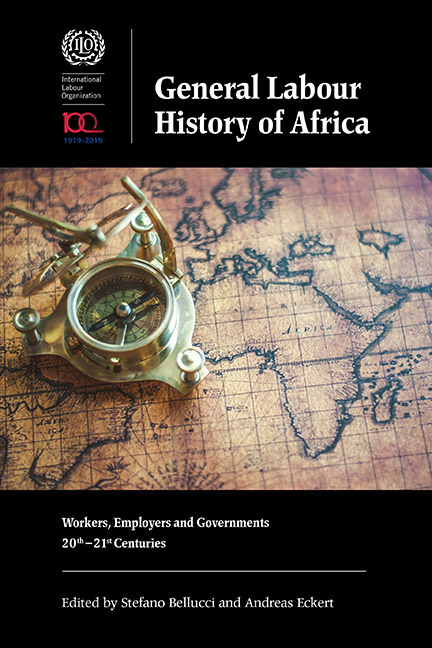Book contents
- Frontmatter
- Contents
- List of Maps and Figures
- List of Tables
- Notes on Contributors
- Foreword
- Acknowledgements
- The ‘Labour Question’ in Africanist Historiography
- Part I Free and Unfree Labour
- Part II Key Sectors
- Part III International Dimensions and Mobility
- 8 The International Labour Organization
- 9 Labour Migration
- Part IV Varieties of Work
- Part V Entrepreneurs and Self-Employment
- Part VI The State, Unions and Welfare
- Part VII Conclusions
- Select Bibliography
- Index
8 - The International Labour Organization
from Part III - International Dimensions and Mobility
Published online by Cambridge University Press: 21 September 2019
- Frontmatter
- Contents
- List of Maps and Figures
- List of Tables
- Notes on Contributors
- Foreword
- Acknowledgements
- The ‘Labour Question’ in Africanist Historiography
- Part I Free and Unfree Labour
- Part II Key Sectors
- Part III International Dimensions and Mobility
- 8 The International Labour Organization
- 9 Labour Migration
- Part IV Varieties of Work
- Part V Entrepreneurs and Self-Employment
- Part VI The State, Unions and Welfare
- Part VII Conclusions
- Select Bibliography
- Index
Summary
AFRICA AND THE ILO's FOUNDATIONAL YEARS
The relationship between the International Labour Organization and Africa during the first decades after the Organization's founding in Versailles in 1919 was, first and foremost, shaped by the ILO's strong European bias. The ILO built on the European labour experience in more than one aspect: its roots lay in the demands of late nineteenth-century European social reformers and proponents of international labour law, and it had grown out of the immediate effects of the First World War in Europe. The integration of the reformist part of the European labour movement into the war effort in many countries, and the Russian October Revolution of 1917, had created the political environment in which the ILO was founded. Its establishment was in a sense both a reward for European workers’ contributions to the war effort and a safety valve to calm the revolutionary potential of the working class. In the same sense, the ILO's tripartite structure, in which workers’ and employers’ delegates took part next to government representatives in the decision-making process, built on the practical experiences and institutions created by some European countries during the war, which were for the first time institutionalized at the international level by the ILO.
While the ILO's mandate was not restricted to any world region or political and social environment, a tension between the universalistic claims of the ILO's Constitution and a definite bias towards European industrial labour permeated the work of the Organization from the start. Initially, the ILO catered primarily to the needs of industrial wage labourers (including seafarers) in the industrialized countries of the West. Both the standardsetting activities and the technical work in which the ILO engaged during the interwar period reflected this bias. From 1919 onwards, the annual sessions of the International Labour Conference (ILC) adopted international labour standards in the form of Conventions and Recommendations (the latter being instruments that are not binding under international law), dealing with a broad range of issues, from protection of children and women workers in industry through labour inspection to social insurance and employment policies. The common denominator of these activities was that the great majority of these standards dealt with problems specific to the industrialized world. Non-industrial labour, including agricultural labour – although within the competence of the ILO – was given much less attention.
- Type
- Chapter
- Information
- General Labour History of AfricaWorkers, Employers and Governments, 20th-21st Centuries, pp. 223 - 264Publisher: Boydell & BrewerPrint publication year: 2019

